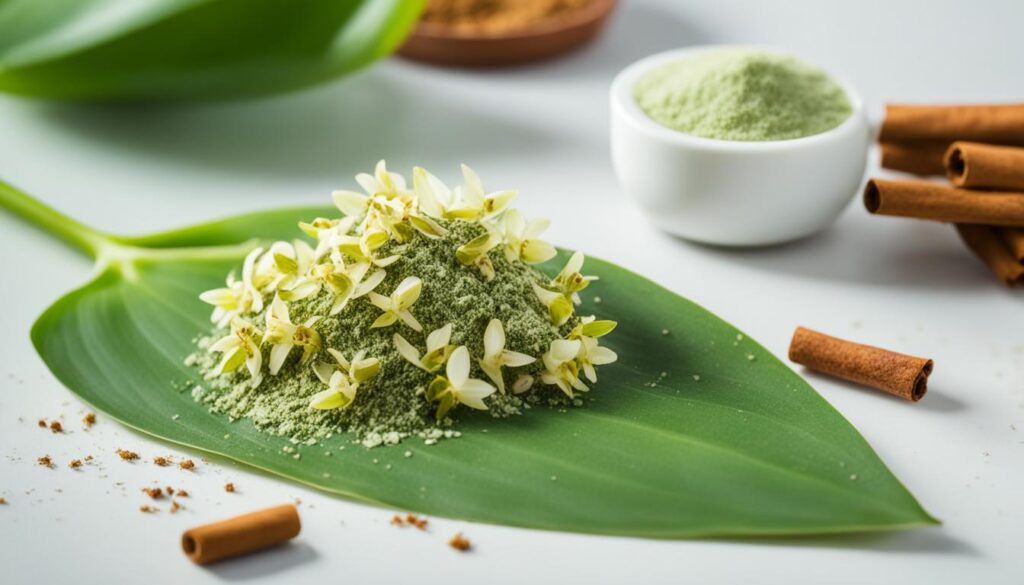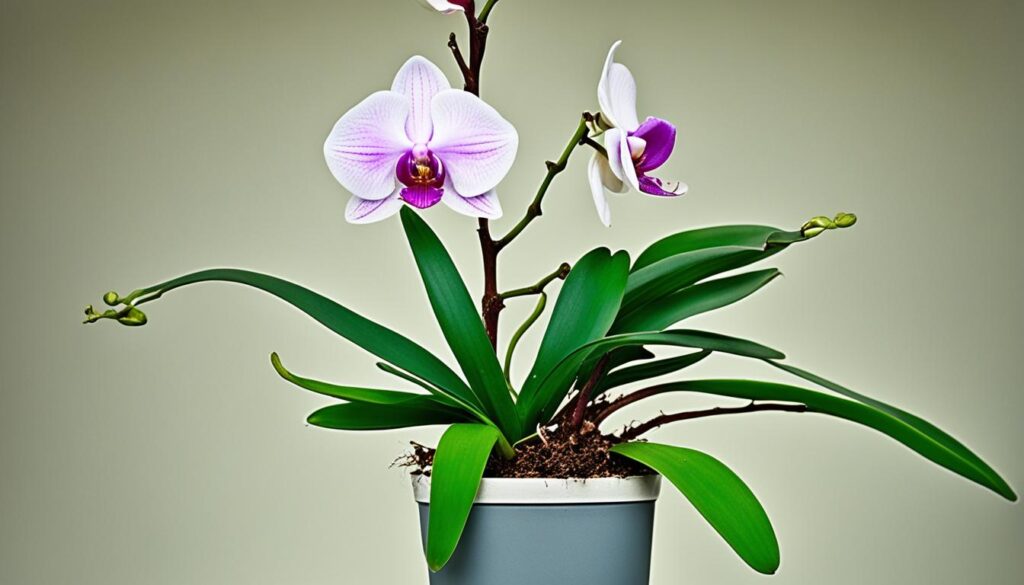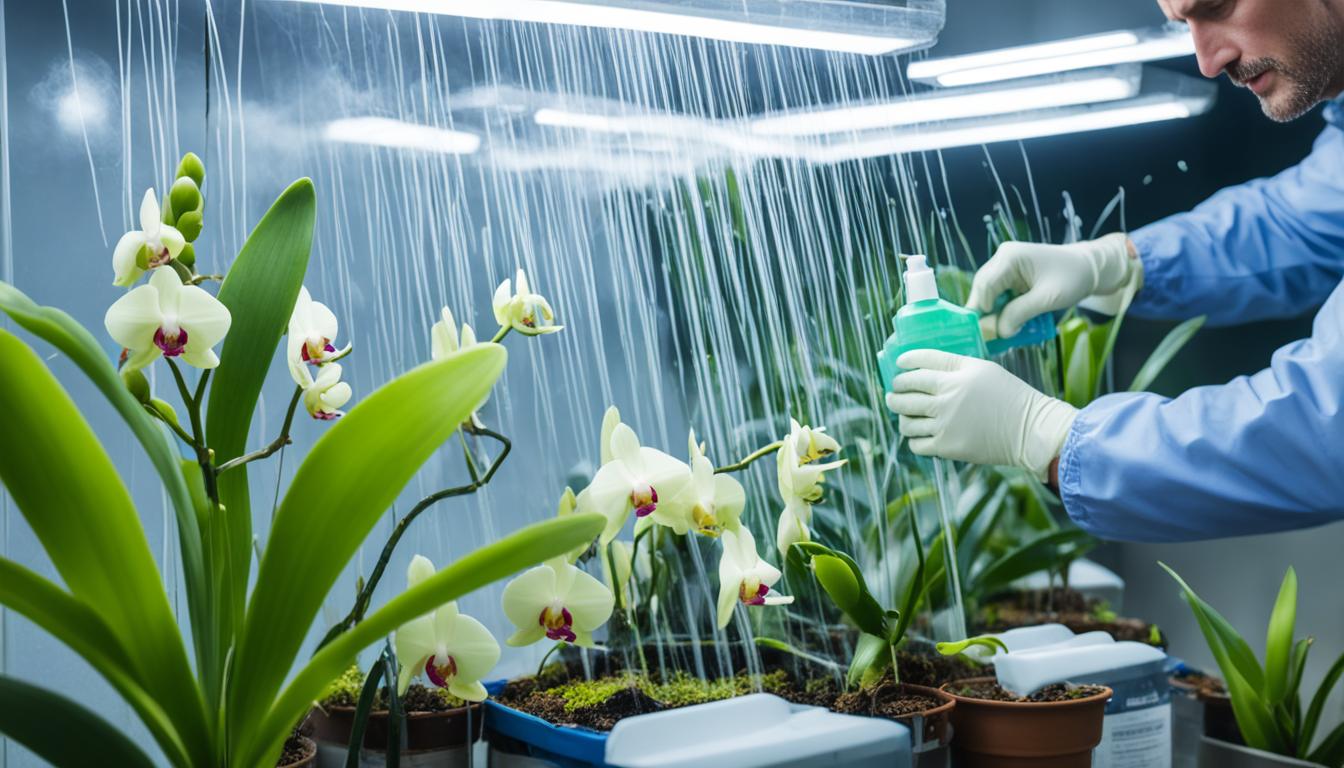As an orchid care enthusiast, I’ve always marveled at the delicate balance these exotic plants require to flourish. But did you know that the same warm and humid conditions that nurture the vibrant life of orchids also invite a silent threat?
Fungal infections, lurking in the shadows, can take hold before you know it, turning lush greenery into wilted memories. My journey has led me through dense information thickets to discover vital strategies for the prevention and cure of fungal diseases ensuring robust plant health.
Let’s embark together on a quest to shield our beloved orchids from these insidious adversaries.
Key Takeaways
- Understand the importance of creating an environment that repels fungal diseases while nurturing orchid health.
- Recognize the urgency of early fungal disease treatment to save your orchids.
- Learn how cleanliness, watering practices, and good air circulation contribute to disease prevention.
- Equip yourself with knowledge about common fungal issues and their specific remedies.
- Be prepared to take decisive action at the first signs of an infection to maintain the beauty of your orchids.
Understanding Orchid Fungal Infections
As an orchid enthusiast, it’s essential to be adept at identifying and addressing fungal infections, which are common threats to these beautiful plants.
Integrating knowledge about the types of fungi and their symptoms can lead to more effective care and treatment, ensuring the longevity and vibrancy of your orchids.
Common Types of Fungal Infections in Orchids
The delicate balance of conditions that orchids thrive in can also predispose them to fungal infections. Within the orchid-growing community, some fungi have earned notoriety, including Cercospora, Botrytis, Guignardia, and Phyllosticta. These pathogens can wreak havoc on orchids, but with the right knowledge, their impact can be mitigated.
Recognizing the Signs of Fungal Diseases
Timely intervention is key in the fight against orchid fungal disease. Learning to spot the early signs of orchid disease is a critical skill. For instance, yellow spots from Cercospora may start off innocently but left unchecked, can lead to significant deterioration.
Here’s a closer look at the telltale signs presented by some of these fungi:
| Fungus | Infected Orchid Part | Visual Symptoms |
|---|---|---|
| Cercospora | Leaves, Stems | Yellowing spots that darken and may necrotize |
| Botrytis | Flowers | Brown flecks or patches, often appearing water-soaked |
| Guignardia | Leaves, Pseudobulbs | Black or dark-purple elongated spots |
| Phyllosticta | Leaves, Pseudobulbs | Similar to Guignardia with dark spots, sometimes with a yellow halo |
In the face of these symptoms, the prognosis of your orchids will largely depend on your swift and precise response. Learning to differentiate between the infections and understanding their progression is paramount in administering timely care to the affected plants.
Strategies for Orchid Fungal Infection Prevention
As an orchid enthusiast, I’ve learned that preventing orchid diseases requires a proactive approach. Understanding and regulating the balance of environmental conditions is key to keeping fungal infections at bay.
Attention to details such as ideal orchid humidity and air movement for orchids goes a long way in maintaining plant health and vigor. Here, let’s discuss how to create the optimum growing conditions and why sanitation is indispensable in the life of an orchid.
Optimizing Growing Conditions for Orchids
Orchids are renowned for their beauty, but they are also prone to fungal diseases if not cared for properly. I always emphasize the importance of monitoring the humidity levels because too much moisture can create a breeding ground for pathogens.
The goal is to maintain an ideal orchid humidity level, which typically ranges between 40% to 70%, depending on the variety. Providing ample air movement around the plants is also critical, as it helps prevent excess moisture on the leaves and stems, thus reducing the potential for fungal growth.

Additionally, I recommend adjusting the watering schedule to the early morning, which allows any excess water to evaporate during the day. Evening watering can sometimes result in water remaining on the foliage overnight, which could lead to fungal issues. A balance of these factors can effectively contribute to preventing orchid diseases, thereby ensuring your orchids stay healthy and flourish.
Importance of Air Circulation and Sanitation
In my experience, I’ve seen how adequate air movement for orchids serves as a preventative measure against the stagnation of moist air, which fungi love. Ensuring a gentle, constant airflow around the orchids can significantly reduce the occurrence of fungal problems.
This can be achieved by using a small fan in the growing area or providing natural airflow through strategic placement in the home or greenhouse.
Sanitation is another aspect I take seriously in my orchid care routine. Sterilizing tools after each use to avoid cross-contamination and removing any fallen debris or dead plant material promptly goes a long way. Let’s look at a table that breaks down the essential preventative measures for orchid care:
| Preventive Measure | Description | Benefits |
|---|---|---|
| Ideal Humidity Levels | Maintain 40%-70% humidity | Lowers disease risk, promotes healthy growth |
| Proper Watering Time | Water in the early morning | Prevents water from sitting on leaves overnight |
| Air Circulation | Use fans or natural airflow | Reduces excess moisture and deters fungal growth |
| Tool Sanitation | Sterilize tools after each use | Prevents the spread of pathogens |
| Clean Growing Area | Regularly remove plant debris | Keeps the area free from potential disease sources |
Adapting these strategies has made a significant difference in my journey of growing and maintaining healthy orchids. By focusing on prevention, I find joy in the resilience and longevity of my cherished plants.
Battling Orchid Fungal Infections: Treatment Options
When I’m treating orchid fungal infections, my first step is to carefully remove any visibly infected plant parts with sterilized tools. This helps prevent the disease from spreading to healthy areas.
After that, selectively applying the right fungicide is essential for managing the infection and revitalizing infected orchid care.

Below, I’ve outlined a table of fungicides recommended for specific orchid pathogens. Remember to follow the manufacturer’s instructions for fungicide use to ensure efficacy and safety.
| Fungal Pathogen | Recommended Fungicides | Application Notes |
|---|---|---|
| Cercospora | Captan, Thiophanate Methyl, Mancozeb | Apply as per the label, usually at the first sign of infection |
| Botrytis | Phyton 20, Daconil | Ensure coverage of all flowers, especially during moist conditions |
| Guignardia and Phyllosticta | Dithane M45 | Use with caution, particularly during cooler, wetter weather |
For effective orchid recovery, the isolation of the infected individual is crucial in a clean environment to avoid cross-contamination.
With diligence and care, even severely afflicted orchids can be brought back to health, exemplifying the resilience of these beloved plants.
Home Remedies and Organic Solutions for Orchid Care
As a devoted gardener, I have always been an advocate for using organic orchid treatment methods that are gentle on the environment and effective in maintaining plant health.
Among the various organic solutions I utilize, hydrogen peroxide for orchids serves as an excellent ally in fighting fungal infections.
This common household item not only cleans but also oxygenates the soil, providing a disease-free environment for my precious orchids.
In my experience, another nature-derived remedy that has proven invaluable is the application of cinnamon paste as disinfectant.
After pruning or when damage occurs to the orchid, I apply a thin layer of this spice mixture directly to the wounds. Cinnamon’s natural antifungal properties help seal the cut and prevent infection.

Maintaining proper air circulation is another key practice I follow. Orchids thrive in environments that mimic their natural airy habitats, which means diligent monitoring of airflow around the plants to discourage the growth of pathogens.
Furthermore, keeping the growing area pristine by regular removal of fallen leaves and spent blooms goes a long way in disease prevention. When it comes to sanitizing tools, a simple yet effective organic solution is the use of a rubbing alcohol or bleach solution, ensuring any potential contaminants are eradicated.
Organic treatments not only nurture plants but also contribute to a sustainable ecosystem, fostering a green thumb in harmony with nature.
- Hydrogen Peroxide: Aerates soil, disinfects wounds, combats fungal growth.
- Cinnamon Paste: Natural antifungal agent, seals plant wounds, prevents infection.
- Air Circulation: Mimics natural conditions, reduces moisture accumulation, limits pathogen development.
- Tool Sanitization: Prevents spread of disease, keeps a sterile growing environment.
| Organic Solution | Purpose | Application Method |
|---|---|---|
| Hydrogen Peroxide | Fungal treatment and soil aeration | Spray directly on soil and base of plant |
| Cinnamon Paste | Natural disinfectant for wounds | Apply a thin layer on fresh cuts |
| Rubbing Alcohol/Bleach Solution | Sanitizing tools and surfaces | Clean tools post usage, treat work surfaces |
In the quest for healthy orchids, I have found that these organic solutions are not only Earth-friendly, but they are also instrumental in nurturing vibrant and resilient orchids.
Do remember, consistency in application and attention to the unique needs of your orchids are essential ingredients of success in my approach to orchid care.
Professional Insights on Treating Orchid Fungal Infections
Confronting fungal infections in orchids demands expertise and precision to ensure effective treatment and minimize plant stress. It’s reassuring to know that through professional insights on fungicide efficacy, orchid surgery, and recovery after fungal infection, we can ensure the health and renewal of these magnificent plants.

Effective Fungicides for Orchid Fungal Infections
I can affirm that selecting the right fungicide plays a pivotal role in combating fungal infections in orchids. Through my own hands-on experience and outcomes achieved, I’ve noted particular fungicides that stand out for their efficacy.
| Fungicide | Type | Application | Function |
|---|---|---|---|
| Copper-based insecticidal soaps | Contact | Spray on affected areas | Preventive and curative functions |
| Beneficial fungi | Biological | Apply to soil or spray on plant | Competition and suppression of harmful fungi |
| Physan solution | Contact | Soak or spray method | Disinfectant to eliminate fungal spores |
Surgical Intervention and Plant Recovery Tips
On occasions, the most judicious option for an infected orchid is surgical removal of infected tissue. This delicate maneuver calls for precise cuts and aseptic techniques.
Including a margin of healthy tissue around the infected area ensures the infection is entirely removed. It’s essential to disinfect shears before and after each cut to prevent the spread of infection.
- Use sterilized cutting tools
- Include a small margin of healthy tissue when excising infected parts
- Avoid touching the cut with the infected plant parts
In the aftermath of surgery, recovery is facilitated by optimizing the orchid’s environment. I encourage focusing on air movement around the plants and ensuring water does not sit on leaves overnight, as this can be a precursor for further fungal issues.
- Enhance air circulation
- Avoid water accumulation on foliage
- Monitor plant health and watch for signs of improvement or any further infection
By adhering to these professional practices, I’ve seen remarkable recoveries, even in orchids that have undergone substantial fungal infection-related surgery. Their resilience is remarkable, and with these careful measures, they can return to their former splendor.
Conclusion
In wrapping up our journey through the intricate challenges of orchid health management, I’ve outlined the paramount importance of being proactive in preventing orchid fungal disease.
Vigilant oversight and prompt action are the twin pillars upon which robust orchid health is built. As we have discovered, these captivating plants possess a delicate balance, requiring precise conditions to flourish without succumbing to the perils of fungal adversaries.
It is my hope that this guide has equipped you with the necessary tools and knowledge to both preempt potential fungal threats and tackle any infections that may arise.
Just remember, the key to maintaining healthy orchids lies in the synthesis of prevention, prompt remedial actions, and consistent care. By fostering a conscientious and informed approach to orchid nurturing, replete with a keen eye for early signs of distress, your plants can enjoy a verdant and vigorous existence.
Whether through the judicious application of effective fungicides, the precise execution of surgical interventions, or the maintenance of sanitary and optimal growing conditions, your efforts will be rewarded with the continued splendor of your orchids.
It is through our shared dedication to these extraordinary plants that we can ensure their legacy as a source of natural beauty and botanical wonder.
FAQ
What are the most common types of fungal infections in orchids?
The most common fungal infections in orchids include Cercospora, Botrytis, Guignardia, and Phyllosticta. Each has distinct symptoms which can help with early identification and treatment.
How can I recognize the signs of fungal diseases in my orchids?
Signs of fungal diseases in orchids range from yellow spots on leaves, indicating a potential Cercospora infection, to brown spots on flowers, often caused by Botrytis. Look for black or dark-purple spots on leaves or pseudobulbs as signs of Guignardia or Phyllosticta.
What are effective strategies for preventing orchid fungal infections?
Preventing orchid fungal infections involves balancing humidity with air circulation, avoiding low evening temperatures, sterilizing tools, and removing dead plant material. Isolation and careful monitoring of new plants can also be effective preventative measures.
How can I optimize the growing conditions for my orchids to deter fungal growth?
To optimize growing conditions for orchids and minimize fungal growth, ensure good air circulation, maintain reasonable humidity levels without excessive moisture, and avoid overwatering. Also, keep your orchid area clean and at a stable temperature to discourage fungal proliferation.
What are the best practices for air circulation and sanitation in orchid care?
Best practices for air circulation involve using fans or opening windows to facilitate airflow. Sanitation practices include regularly sterilizing tools, cleaning the growing area, and disposing of any fallen debris promptly to prevent fungal spores from thriving.
What should I do if my orchid is already infected with a fungus?
If your orchid is infected with a fungus, you should carefully remove the visibly affected areas with sterilized tools and apply recommended fungicides like Captan or Thiophanate Methyl, among others, following the manufacturer’s instructions for application.
Are there any natural remedies for treating orchid fungal infections?
Yes, natural remedies like Hydrogen Peroxide sprays can be used to treat orchid fungal infections. Applying a cinnamon paste to the cut areas acts as a natural disinfectant. Maintaining cleanliness and sterilizing equipment with a bleach solution can also be helpful.
Can you offer professional insights on how to treat an orchid’s fungal infections?
Professional insights suggest using specific fungicides like copper-based solutions or physiological solutions for fungal treatment. It is also recommended to include a margin of healthy tissue while surgically removing infected parts to prevent the spread.
Should I cut off a piece of healthy tissue when removing infected parts of my orchid?
Yes, when surgically removing infected tissue from an orchid, it is a good practice to also remove a small margin of healthy tissue to ensure that all the infection is eliminated.
What steps should I take post-surgery to aid my orchid’s recovery from a fungal infection?
After surgically removing infected orchid parts, enhance cultural practices such as increasing air movement and avoiding water accumulation on leaves and flowers to aid recovery and prevent future fungal outbreaks.
How important is it to monitor and maintain the health of an orchid to prevent fungal infections?
It is crucial to monitor and maintain orchid health consistently as it plays a fundamental role in the prevention of fungal infections. Regular inspections for early signs of disease, along with timely intervention, are key to keeping orchids thriving.


Leave a Reply